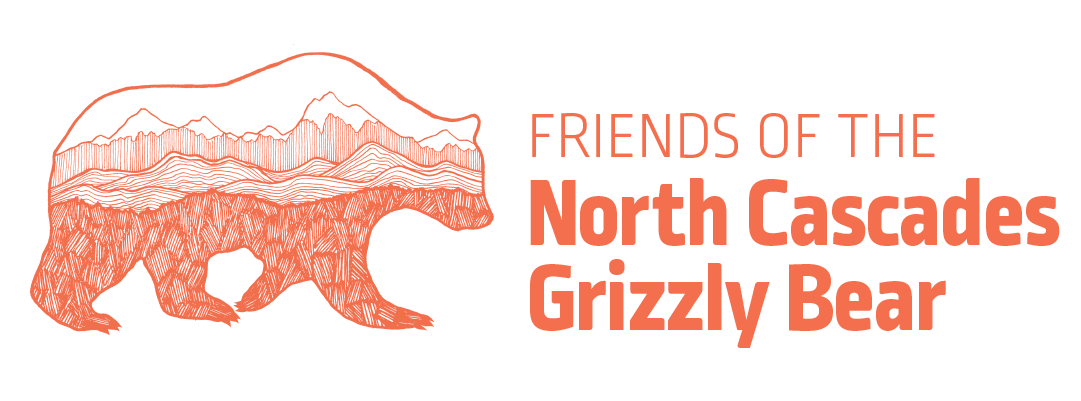BY JOE SCOTT, CONSERVATION NORTHWEST, INTERNATIONAL PROGRAMS DIRECTOR
After more than two decades of planning for grizzly recovery, it’s time to speak up for America’s most iconic symbol of the wild, once and for all.
The more things change, the more they stay the same. It’s been 22 years since then U.S. Fish & Wildlife Service Regional Director Ralph Morgenweck signed the 2nd edition of the North Cascades Grizzly Bear Recovery Plan.
Ralph was almost before my time—and that’s saying something. The 1997 Plan “Chapter” was preceded by a five-year habitat analysis, completed in 1993, that established the necessary habitat quality of the North Cascades to house a viable grizzly bear population.

I doubt even old Ralph would have envisioned that it would take more than two decades to complete the next step—a Final Environmental Impact Statement (FEIS) intended to guide the restoration of the iconic grizzly to the wild, wide-open spaces of the wildest place in the Pacific Northwest. But here we are.
Federal agencies finally initiated the EIS process in early 2015, with a Draft EIS released in 2017. It was supposed to have taken two to three years to complete the FEIS and get to the “how” of grizzly recovery. Four and a half years in—and a couple more unexplained delays that sandwiched a visit from now long-gone Interior Secretary Ryan Zinke to Sedro Woolley to affirm his Department’s support for North Cascades grizzly recovery—the process from hell has lurched to life again.
The agencies have initiated yet another 90-day comment period on the Draft EIS after receiving more than 120,000 comments during the original comment period, the vast majority of them supportive of Alternative C: Incremental Restoration.
But we’re in the grizzly bear recovery game for the long run, so what’s another 90-day comment period?
The grizzly is still the consummate North American wildlife icon. It still has immeasurable ecological and cultural value for our ecosystems and Indigenous and non-Indigenous communities. And it remains the missing piece in an otherwise rebounding Pacific Northwest wildlife menagerie, where wolves, wolverines, and fishers are once again reestablishing themselves.
A short film from wildlife filmmaker and host Chris Morgan that we co-produced in 2017.
Stepping up for grizzlies
Ironically, with all the processes’ twists and turns and political and bureaucratic roadblocks, one would think that the federal agencies were proposing to drop hundreds of grizzly bears from fleets of black helicopters into the Cascades. The reality is that grizzly bear recovery is a very long, painstaking, and tedious undertaking, particularly when starting a new population. There are presently no grizzlies known on the US side of the North Cascades.

Even if the government decides to transplant some number of bears into the Cascades, grizzlies still don’t grow on trees. And restarting a grizzly bear population with transplants requires a particular demographic—mostly sub-adult females that haven’t had contact with people or their foods and the occasional male to balance things out.
For further perspective, federal and state agencies have been systematically restoring the once-beleaguered grizzly bears of the Cabinet-Yaak Grizzly Bear Recovery Zone in northwest Montana for nearly three decades. From a tiny population of fewer than 15 bears, there are now an estimated 55-60 grizzlies, entirely as a result of biologists’ efforts to patiently and carefully move a couple bears yearly into the Cabinets from more robust populations. Without such translocations, the Cabinet-Yaak grizzlies would be gone.
Coexisting with grizzly bears
It’s well-documented (NPS report PDF) that grizzly bears have lived in the North Cascades for thousands of years. The habitat and the bear benefit and are tuned to each other. As well, the Great Bear’s cultural roots are strong and deep. Many First Nations peoples assert that the grizzly bear taught the people what to eat, such is the extensive overlap of the foods on which grizzlies and people depend.
Despite the unique charisma of the grizzly bear, we always try to take a coldly unromantic, objective approach to their recovery and the unavoidable issues around it.
Some people have a deep-seated fear of death or injury by grizzlies because of a few well-reported instances of attacks, even though such events are exceedingly rare. It’s undeniably true that on occasion grizzly bears hurt people. But such occasions don’t speak to the millions of backcountry hikers, bikers, hunters, fishers, loggers, researchers, and others who routinely go about their business in the midst of many more grizzlies than will ever populate the North Cascades.

It doesn’t seem like a huge burden to be aware of the steps to avoid harmful human-bear encounters or to carry bear spray when in grizzly bear country. Lots of folks do it. My canisters expire without my ever having to use them. Besides, people kill many more grizzlies than the other way around.
On the pro side, grizzly bears play a necessary ecological role in their natural environments, as all species do. They energize the landscape, and more than any other animal, they represent the wild.
But much more importantly, if we ever hope to reconcile our thirst for wildlands with the needs of the wildlife that depend on it, people must allow space for the grizzly bear and other species with large habitat needs.
And by the way, biologists completed another habitat analysis of the North Cascades Grizzly Bear Recovery Zone in 2018. Once again, it demonstrated that if you’re a grizzly bear, the North Cascades is a pretty good neighborhood with abundant foods and largely undisturbed, rugged habitats, even in the face of climate change.
Once again, we need folks to pipe up for the grizzlies of the North Cascades. Please submit comments supporting grizzly bear recovery even if you’ve already done so. They won’t return on their own. And this could be our last shot at giving them a recovery boost before they’re gone from our region for good.


